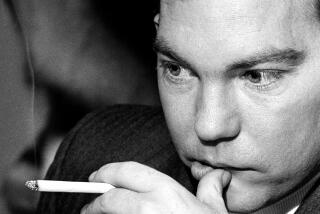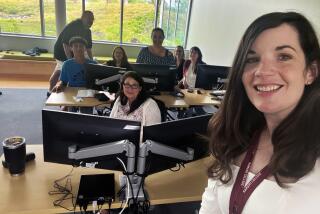Emotional Archeology: Digging Into the Past to Identify MIAs
Among the tragedies of the Vietnam War is the suffering of families of the MIAs--those listed as missing in action. Some 2,500 American servicemen remain unaccounted for.
The U.S. government is working to whittle down that number. But it’s slow going.
I’d like to tell you about two men from Orange County who have been devoted to that task during the last year. They are Steve Dibble of Orange and Rod McLean of Aliso Viejo, archeologists for the U.S. Army Corps of Engineers.
On Monday, the Corps released reports the two made following trips to Vietnam last year. Their separate missions were to find remains of two pilots whose planes were shot down over North Vietnam. The two archeologists were not available for interviews--Dibble is back in Vietnam, and McLean is on a project out of the area. But you sense from their words that none of the government work they’ve done before has meant so much to them.
The Corps of Engineers assigns archeologists to almost all its civil engineering projects so that fossil items uncovered during its excavations can be preserved. A good example is excavation work the Corps of Engineers will do for the building of the U.S. Food and Drug Administration laboratory at UC Irvine. McLean will be heavily involved in that project.
But the Vietnam trip was a chance to do something different. McLean states that he had two main interests: helping out in what he considered a noble cause and directing archeology in another country. He adds: “The former would become stronger as the mission developed.”
A Navy pilot had been assigned a bombing run over central North Vietnam. The plane was shot down in 1967 by a surface-to-air missile. The wingman aboard the plane managed to survive and was taken prisoner. Many years after his release, he provided U.S. officials a general description of where the plane had gone down. Added to that were descriptions from two villagers who had witnessed the crash and had actually buried the pilot.
McLean and his crew members prepared for a 30-day trip. After flying to Hanoi from Thailand, they traveled eight hours by car to reach the rural site, 40 kilometers from the town of Ha Tinh.
McLean’s job was to supervise the search for remains of the missing pilot. McLean’s team included Army, Air Force and Marine personnel. Over his objections, the team insisted that custom dictate that he be called “Doc.” That added interesting confusion, for there was also a medic in the group called “Doc.”
Once at the site, McLean interviewed the two Vietnamese men who had buried the pilot 30 years earlier. They showed the American crew the hill where the plane crashed, and a ditch at the foot of the hill where they seemed to think they had buried the pilot.
McLean asked the two to outline a 20-by-7-meter area where they thought the body might be. It was covered by dense brush and a field of tea plants.
“All we had to go on was the word of these two men,” McLean writes. “I was concerned, but I did not want to draw unfair conclusions prematurely. We had three weeks to find our pilot or say he was not there.”
Some 40 Vietnamese were assigned to help with the digging and washing of unearthed material in wire mesh screens. The first week produced no results.
But then, McLean writes: “I heard ‘Doc’ yelled from the east end that was several meters outside the original area marked by the witnesses. In typical fashion, both the medic and I looked up. But when the medic [later] also started yelling ‘Doc,’ my heart skipped a beat.”
At the bottom of a trench, they found two teeth attached to something. McLean: “Careful excavation with dental picks and trowels exposed a portion of the skull, including a part of the lower jaw, and 17 more teeth.”
Dental work on the teeth made it almost certain that this was an American. The villagers could not have afforded such dental work. McLean poignantly adds:
“I cannot fully express the emotion of the moment. If you can imagine great happiness, along with a sense of accomplishment, yet profound sadness.”
The next two weeks were spent digging just to ensure that there were no other body parts to be found. McLean: “For the sake of the family, I did not want to leave any of him behind.”
Before McLean’s crew left the country, the Vietnamese officials involved wanted to hold a small party to celebrate the group’s success. McLean writes that he would have preferred something to honor the memory of this pilot and remember his family. But he was told by military personnel that, for political reasons, that wouldn’t be wise. So the American personnel waited until the Vietnamese officials had gone to bed. Then privately, McLean states, “We drank a toast to the man who gave his life for his country.”
On reflection later, McLean writes that the team he worked with saw their mission as “a sacred duty. We were all bound together by the idea that if we had a father, brother, husband or some other relative missing in action, we would want someone to look for them.”
Dibble’s account of a separate search is similar. A Navy pilot in 1966 had gone down near the village of Bao Son. His radar intercept officer ejected and was taken as a prisoner of war. But he did not know the fate of his pilot.
The digging site was based on the word of a 73-year-old villager who said he had witnessed the crash 31 years earlier and had watched as others buried the pilot.
Dogs had attacked part of the remains soon after the pilot’s burial. But Dibble’s crew was able to come up with bone and teeth fragments. Other items were found, like part of a cigarette lighter and clothing zipper pieces. One villager produced a portion of a flight helmet his wife had found after the crash.
In both the McLean and Dibble projects, positive identification was eventually made after many months, and the families of the pilots were notified. The names have been withheld for the sake of their privacy.
Fred-Otto Egeler, spokesman for the Los Angeles district of the Army Corps of Engineers, where both archeologists work, says the families were thankful: “On one hand, it ends all hope that their loved one somehow survived. But also, it provides closure that they need.”
*
Jerry Hicks’ column appears Tuesday, Thursday and Saturday. Readers may reach Hicks by calling the Times Orange County Edition at (714) 966-7823 or by fax to (714) 966-7711, or e-mail to jerry.hicks@latimes.com.
More to Read
Sign up for Essential California
The most important California stories and recommendations in your inbox every morning.
You may occasionally receive promotional content from the Los Angeles Times.










